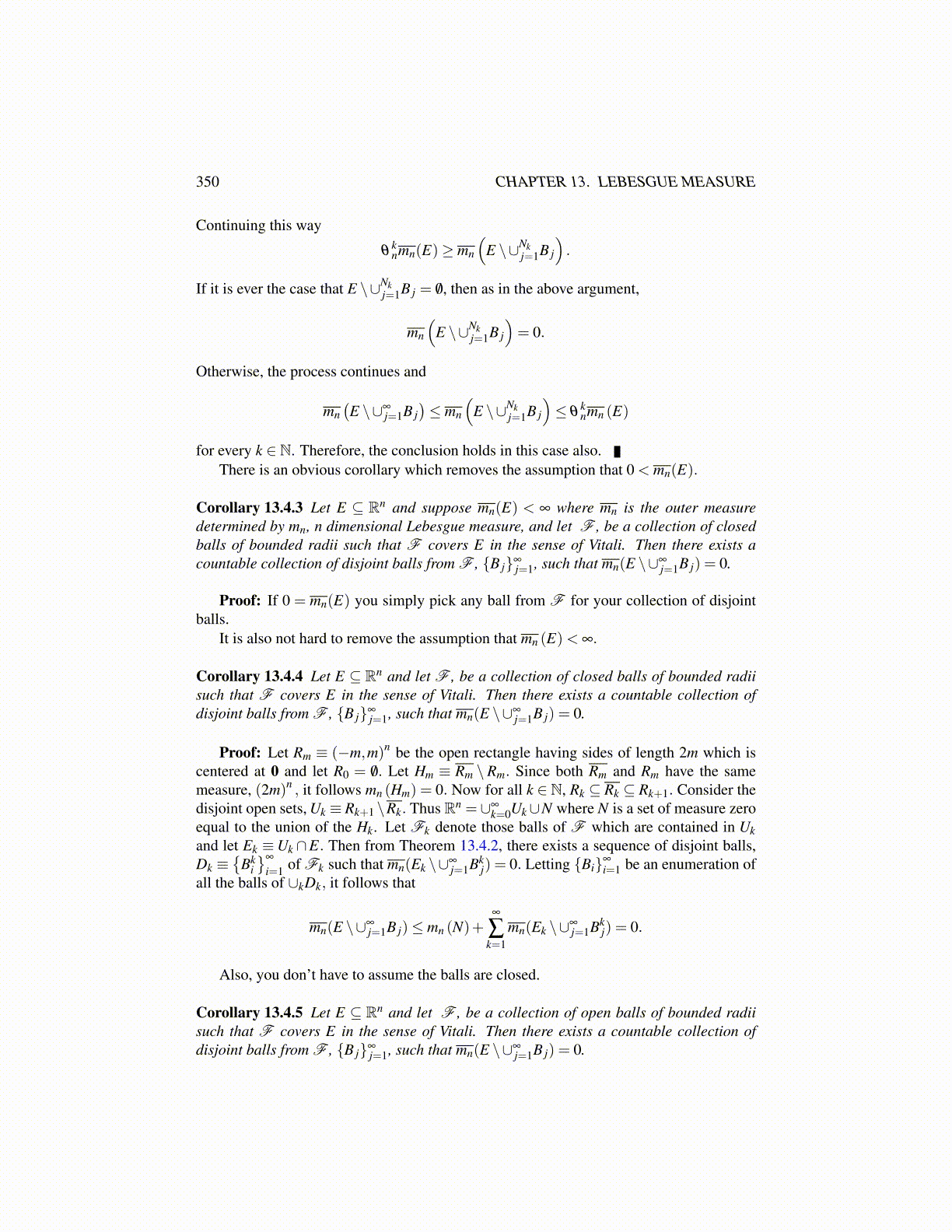
350 CHAPTER 13. LEBESGUE MEASURE
Continuing this way
θknmn(E)≥ mn
(E \∪Nk
j=1B j
).
If it is ever the case that E \∪Nkj=1B j = /0, then as in the above argument,
mn
(E \∪Nk
j=1B j
)= 0.
Otherwise, the process continues and
mn(E \∪∞
j=1B j)≤ mn
(E \∪Nk
j=1B j
)≤ θ
knmn (E)
for every k ∈ N. Therefore, the conclusion holds in this case also.There is an obvious corollary which removes the assumption that 0 < mn(E).
Corollary 13.4.3 Let E ⊆ Rn and suppose mn(E) < ∞ where mn is the outer measuredetermined by mn, n dimensional Lebesgue measure, and let F , be a collection of closedballs of bounded radii such that F covers E in the sense of Vitali. Then there exists acountable collection of disjoint balls from F , {B j}∞
j=1, such that mn(E \∪∞j=1B j) = 0.
Proof: If 0 = mn(E) you simply pick any ball from F for your collection of disjointballs.
It is also not hard to remove the assumption that mn (E)< ∞.
Corollary 13.4.4 Let E ⊆ Rn and let F , be a collection of closed balls of bounded radiisuch that F covers E in the sense of Vitali. Then there exists a countable collection ofdisjoint balls from F , {B j}∞
j=1, such that mn(E \∪∞j=1B j) = 0.
Proof: Let Rm ≡ (−m,m)n be the open rectangle having sides of length 2m which iscentered at 0 and let R0 = /0. Let Hm ≡ Rm \Rm. Since both Rm and Rm have the samemeasure, (2m)n , it follows mn (Hm) = 0. Now for all k ∈ N, Rk ⊆ Rk ⊆ Rk+1. Consider thedisjoint open sets, Uk ≡ Rk+1 \Rk. Thus Rn = ∪∞
k=0Uk∪N where N is a set of measure zeroequal to the union of the Hk. Let Fk denote those balls of F which are contained in Ukand let Ek ≡Uk ∩E. Then from Theorem 13.4.2, there exists a sequence of disjoint balls,Dk ≡
{Bk
i}∞
i=1 of Fk such that mn(Ek \∪∞j=1Bk
j) = 0. Letting {Bi}∞
i=1 be an enumeration ofall the balls of ∪kDk, it follows that
mn(E \∪∞j=1B j)≤ mn (N)+
∞
∑k=1
mn(Ek \∪∞j=1Bk
j) = 0.
Also, you don’t have to assume the balls are closed.
Corollary 13.4.5 Let E ⊆ Rn and let F , be a collection of open balls of bounded radiisuch that F covers E in the sense of Vitali. Then there exists a countable collection ofdisjoint balls from F , {B j}∞
j=1, such that mn(E \∪∞j=1B j) = 0.